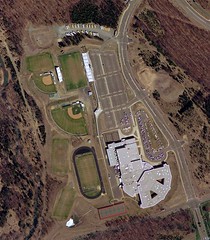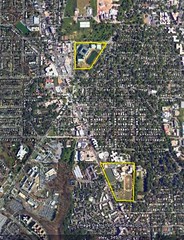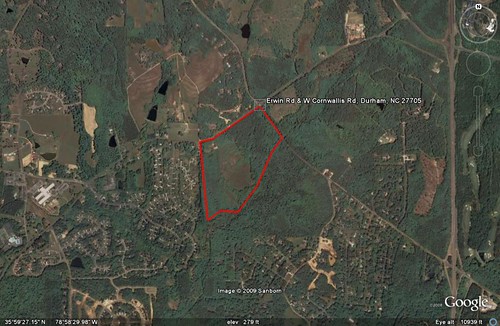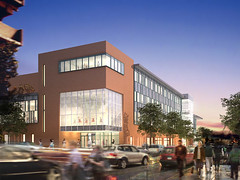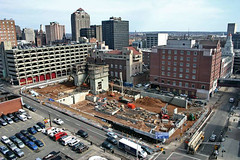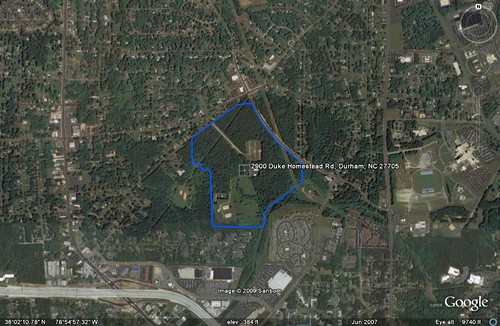School sprawl is alive and kicking in Durham

Posted July 30, 2009 at 1:20PM
Earlier this week I received a message from my friend R, whose opening sentence was "Every time I see something in your blog about good school locations, it looks like an elementary school." Hmmmm. I think she is mostly right, certainly so when I posted my photo essay on better alternatives to school sprawl last year. In her home city of Durham, it seems the current controversy is over the location of a new high school, not an elementary school.
New high schools are some of the very worst examples of what we are doing wrong, as you can see in my reprised images, at the top of the post, of high schools in Northern Virginia and McHenry County, Illinois.
So I sent R a Google Earth image of the Woodrow Wilson High School site in my neighborhood (marked in yellow at the top of the GE image, just below) that I think is very nonsprawling and compatible with smart growth values. Look closely at the accompanying photo and you can see new solar panels on the school's roof. Wilson is a public school serving 1700 students; before she graduated a couple of years ago, my next-door neighbor's daughter was able to walk to and fro.
At the south (bottom) end of the image is the Sidwell Friends School, a private institution serving 1100 students (not all of whom are in high school). Sidwell's campus occupies 15 acres, so I would say that Wilson's is in the 10-12-acre range.
My friend was unimpressed: "I doubt that any of the schools in your area are new," came the response. Well, no, which was my point. In older neighborhoods in America, we have done a great job of fitting schools of all levels into walkable communities. Durham could still do that, if it wanted. Some communities are in fact doing that now, using infill and redevelopment sites, and I'll get to some examples later in the post.
That's not what the authorities in Durham want to do, though. Here, outlined in red, is the proposed 50-acre site (four or five times bigger than Wilson's property) for a new high school, beyond the edge of town. Yikes:
I won't say that there is nothing around there, but what's there now is scattered and absolutely nothing is walkable. There is an organized opposition, trying to garner public opinion to kill the proposal. Now, to be honest, it looks like a NIMBY group whose motives may not be pure in this matter. They probably want to be the last ones to move to the latest patch of sprawl and keep others out to make sure it stays low-density.
But in this case they are right. This is a terrible site that does none of the things we want a smart school site to do and be. For a contrast, look not just at the DC sites in my neighborhood but also at some even more urban locations below. The construction photo and renderings are of a new high school in New Haven; the Google Earth image denotes a new high school site in Columbus, Ohio:
There are similar in-town schools being built on infill and redevelopment sites in Los Angeles and Manhattan, being considered in Yarmouth, Nova Scotia and being proposed in Seattle. When I suggested to R that the folks in Durham could build on a redevelopment site, she basically said that there was no such thing in downtown Durham (huh?), and that a possible suburban grayfield alternative had fallen through.
I was starting to get exasperated at this point, since R had a reason why any example I brought up, old or new, wasn't applicable, in her opinion, to Durham. What it came down to was that the authorities there really wanted a greenfield property, of around 50 acres or more so they could build, among other things, nine athletic fields on-site. And R wanted an example of that in a nonsprawling location. Basically, a sprawl site but somewhere other than in sprawl.
Are you kidding me? If those are your criteria, you're going to build a large campus of parking lots and one-story buildings in an outlying location. Those of us who care can't simply accept the authorities' current criteria: we have to muster the facts, examples, advocacy and, ultimately, public will to do things differently, and maybe even to conceive education differently, with being placed inside a community valued for the kids as well as for traffic and the environment.
That's not easy, and it's a shame that doing the right thing requires that much work and volunteer time, with the deck stacked against us. It's also a bit unfair of me to pick on R, who values the very same things that I and most of the readers of this blog do and, by the way, has awesome taste in music and sports teams.
To their credit, the opponents of the proposed site have come up with an alternative location, above, currently owned by Duke University and at one point already offered to the school system in Durham. The alternative site is still large and suburban in character; if the authorities could be persuaded to accept it, what would be built there likely would still be sprawling inside the site. But it is a somewhat better location, placed within existing development instead of expanding the regional footprint.
I wouldn't bet on a good outcome to this, unfortunately. (This is North Carolina, after all, where - in my home town! - someone's idea of bicycle safety instruction was to fire a gun at a dad riding a bike with his family.) And I'm sure communities and school districts all across the country are faced with similar circumstances and frustrations, such as the example in upstate New York where kids were actually forbidden to walk or ride their bikes to school. We need to fix this.
